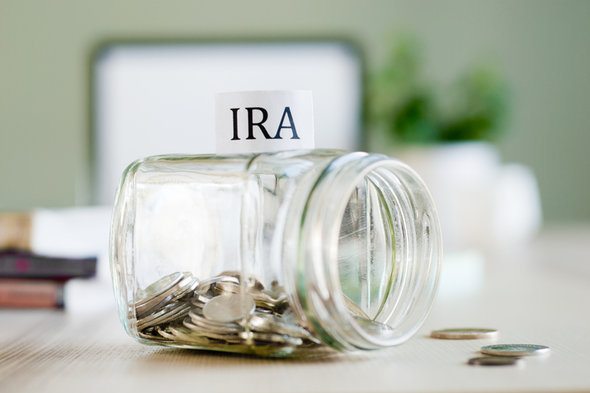You found a new job and can no longer contribute to your previous employer’s 401(k) or 403(b). If your new employer offers an equivalent retirement account, you can directly transfer the money from one account to the other. You can also move the money from your employer’s account into your own individual retirement account (IRA). Either way, you’ll need to do something called an IRA rollover.
Managing your retirement to ensure you have enough to live as you would like can be complicated. A financial advisor’s insight and guidance can make a significant difference in how things turn out for you.
What Is an IRA Rollover?
An IRA rollover is a transfer of funds from one retirement account to a traditional IRA or Roth IRA. IRA rollovers are common when people switch jobs and want to move money from their previous company’s retirement plan, like a 401(k) or 403(b), into an IRA. Rollovers also occur when someone just wants to switch from one IRA to another with better benefits or different investing options. An IRA rollover does not count toward your IRA’s annual contribution limit.
There are two types of IRA rollover – direct and indirect. A direct rollover is a transfer of funds directly from one retirement account to another. You don’t have to pay any taxes with a direct rollover. This is the simplest and best option if you just want to move an entire account. Indirect rollovers are more involved and have more tax implications. With an indirect rollover you get a check for the rollover amount and then deposit the check into your IRA account on your own.
Direct IRA Rollovers
The general process of an IRA rollover is simple. To go through the process, let’s use an example. Say you switched jobs. That means you can no longer contribute to your previous employer’s 401(k) plan. The first step is to decide where you want move the money. If you want to move the money into an IRA, you’ll need to open your own IRA. Another option is to transfer the money into a 401(k) plan with your new employer. The process is the same either way.
Contact your former employer or the administrator of the 401(k). Notify them that you want a direct rollover distribution to another account. If you aren’t sure who to contact, you can find contact information on your last 401(k) statement. To make the rollover, you will need to provide the institution where your IRA is, your name (or the name of the account holder) and the account number for the IRA. Depending on where you have your IRA, the financial institution may also require you to get written confirmation from the 401(k) administrator saying that it’s fine for you to move the funds.
Next the employer will draft a check for the rollover amount. If it can, the employer will send the check right to the financial institution where you have your IRA. This direct rollover is also called a trustee-to-trustee transfer. The administrators of your 401(k) and your IRA are the two trustees in this case.
Indirect IRA Rollovers
Unfortunately, not every employer will give you the option to directly roll over your assets. That’s where an indirect rollover comes into play. With an indirect IRA rollover, the trustee of the original account (your employer in the example above) will send you a check through the mail for the amount of the rollover. Then you need to deposit the check into your IRA account.
The key to an indirect rollover is to deposit the money within 60 days of receiving the check. If you do not deposit the check within 60 days, the IRS will treat it as an early distribution. That means you will have to pay income tax on the amount of the rollover and the 10% penalty for early distribution. The IRS will also charge a withholding penalty if you do an indirect transfer, which complicated things further. We’ll take a closer look at the withholding penalty in the next section.
The Cost of an IRA Rollover

If you transfer funds via a direct IRA rollover, you don’t have to worry about paying any additional taxes. The same is true if you transfer funds directly from one 401(k) to another. The entire amount will simply move from one account to the other. The exception is if you move funds from a tax-deferred plan, like a 401(k), to an after-tax account, like a Roth IRA. Then you would have to pay income tax on the rollover amount.
Things are a little more involved if you transfer your funds via an indirect rollover. In that case, the IRS considers it a distribution since you are receiving a check for the value of your rollover. The IRS charges a withholding penalty of 10% if the distribution is from an IRA and 20% if it is from a non-IRA retirement account. Even if you’re doing a rollover and you plan to deposit all of the funds straight into an IRA, the IRS insists on the withholding penalty.
If you make a rollover from your employer’s 401(k) into an IRA, your employer with have to withhold 20% of the rollover amount. Therefore the check they send you will be for the total rollover amount minus 20%. When you deposit that check, you will need to make up that 20%. If you do not make up the 20%, the IRS will consider that 20% an early distribution that you need to pay tax and a penalty on. This is a bit tricky so let’s bring it all together in an example.
You have $10,000 in your employer’s 401(k) and you want to move it all into your IRA. Your employer can’t do a direct transfer and they send you a check in the mail. The IRS requires your employer to withhold 20% of the rollover, so your check will be for $8,000 ($10,000 minus 20%).
You have 60 days from the time you receive that check to deposit it into your IRA. If you don’t deposit the check within 60 days, the entire $10,000 will be an early distribution in the eyes of the IRS. They’ll charge you income tax on that money and a 10% penalty for early withdrawal. If you do deposit the check within 60 days, you will need to make up the 20% that your employer withheld. The check is only for $8,000, but you still need to deposit the full $10,000 into your IRA. You need to make up that $2,000 with your own savings – all within 60 days. If you can’t get that 20% and you only deposit the $8,000 check, the IRS will view that $2,000 as an early distribution. You will then have to pay income tax and the penalty on that money.
Reporting an IRA Rollover on Your Federal Tax Return
If you receive a check for your rollover, the IRS considers that rollover to be a distribution. That means you need to report it on your taxes even if you don’t have to pay any tax on it.
When you rollover money into an IRA, you will receive a 1099-R form from the trustee who made the distribution. If you are removing funds from your previous employer’s 401(k) then the employer will send you the 1099-R. You need to attach this form to your federal tax return. The 1099-R that you receive will show in box 2a that the entire distribution (the amount you rolled over) is taxable. That isn’t true though, assuming you deposited the full rollover amount within 60 days. To show that the amount isn’t actually taxable, you just report on your federal tax return that it isn’t taxable. Luckily, this is easy to do.
Let’s say you did an IRA rollover of $10,000. You did everything within 60 days, so you don’t have to pay taxes or penalties on that money. You will get a 1099-R form that says the entire $10,000 is taxable even though it isn’t. When you file your taxes, you’ll see that line 15a of Form 1040 is for “IRA Distributions.” You’ll write in $10,000 because a rollover counts as a distribution and you did a rollover of $10,000. Line 15b of Form 1040 asks for the “Taxable Amount.” That is the amount of the IRA distribution that you owe taxes on. If you did everything within 60 days, you don’t owe anything. All you have to do is put “0” on line 15b.
Now you’ve properly reported that you received an IRA distribution (in the form of a rollover) but you don’t owe tax on it. If a professional files your taxes, it’s a good idea to check her work by looking at lines 15a and 15b of Form 1040.
The trustee who received your IRA rollover will also send you a form. This is IRS Form 5498 and it says that you made a rollover contribution to your IRA. You do not have to attach this form to your tax return. It’s strictly for your records. In fact, you might not even receive the form in time to file your taxes.
Rollover Restrictions and Exceptions
You can only make one IRA rollover per 12-month period. This period begins on the day that you make your first IRS rollover and ends 12 months later. If you make more than one rollover per year, you will have to report the additional rollover amounts as gross income on your federal tax return.
This restriction doesn’t apply to eligible rollover distributions from an employer plan, meaning it’s permissible to distribute more than once from the same qualified plan, like a 457(b) or 403(b). It also doesn’t apply to rollovers to Roth IRAs from traditional IRAs.
The Bottom Line

An IRA rollover is common when someone changes jobs and wants to move funds from an employer’s retirement plan into an IRA. The general process isn’t too difficult. Notify your employer and ask to move the funds. In many cases, the employer can transfer the funds directly into your new account or to your new employer’s plan. Otherwise, you will get a check that you need to deposit yourself. Things can get a bit tricky in this case with taxes and withholding. If you get a check, the key is to deposit the funds within 60 days. Waiting more than 60 days will turn the rollover into an early distribution that you need to pay income tax and a 10% penalty on.
Tips for a Successful IRA Rollover
- SmartAsset has a free financial advisor matching service to help you find someone to help you navigate your retirement accounts. First you’ll answer a series of questions about your situation and goals. Then the program will narrow down your options from thousands of advisors to up to three registered investment advisors who suit your needs. You can then read their profiles to learn more about them, interview them on the phone or in person and choose who to work with in the future. This allows you to find a good fit while the program does much of the hard work for you.
- Retirement savings is key to a successful financial plan. See how much money you’ll need for retirement using SmartAsset’s retirement calculator.
Photo credit: ©iStock.com/c-George, ©iStock.com/kupicoo, ©iStock.com/Rawpixel
